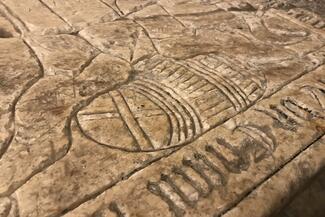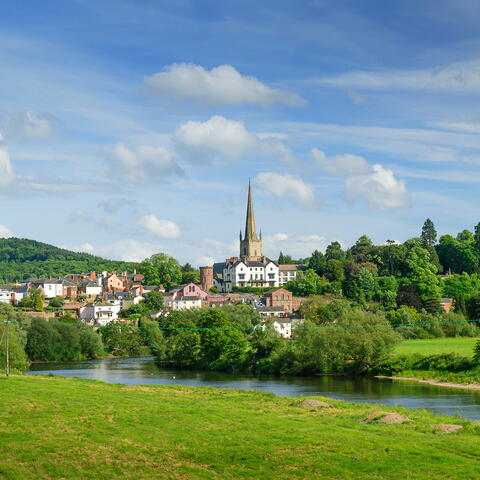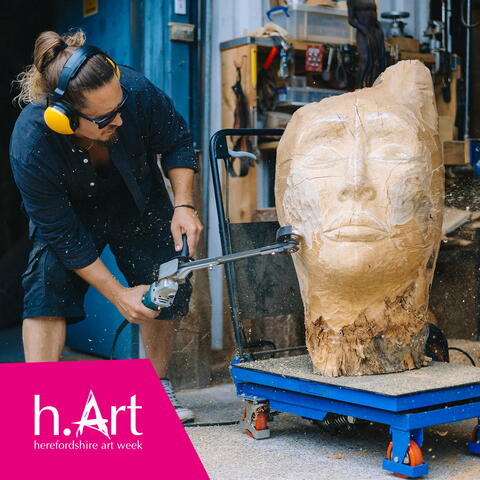Top 10 Treasures at Hereford Cathedral
From two record-breakers to contemporary glass, serene gardens and a guided tour

Hereford Cathedral is home to two record-breakers -the incredible Mappa Mundi, the largest surviving medieval map of the world, and the biggest chained library on the planet. But there’s a host of other treasures to discover, including the magnificent contemporary window by the artist John Maine RA and the serene Chapter House gardens.


1. Mappa Mundi
Hereford Cathedral is famed worldwide for this fascinating gem! It’s the largest surviving map of its kind, dating from about 1290AD, and is an encyclopaedia of 13th-century knowledge, drawn on a single piece of calf-skin (vellum). Hundreds of images are shown from Bible stories, as well as ancient myths and legends, mountain ranges, rivers, cities and all kinds of creatures. At that time, the known world was only Europe, Asia and North Africa. East is at the top, at its centre is Jerusalem and on the edge of the world is the British Isles. In the East is the Day of Judgement with the chained, naked sinners going into the jaws of Hell.
2. Chained Library
Imagine a time when books were so precious they had to be locked up! This rare collection of chained books is displayed on the original oak shelves which date from 1611. As well as very early printed books, there are over 200 handwritten manuscripts, the oldest being the 8th-century Hereford Gospels. The books were chained so that they could be studied, but, crucially, not removed. The chain is attached to the strongest part of the book – the cover. So it looks odd to us, because the pages face outwards.
3. SAS Window
The army’s most secret regiment is based in Hereford and its unique relationship with the cathedral, city and county is celebrated in the stunning Ascension Memorial Window and shrine. Created by John Maine RA, it honours the 75th Anniversary of the foundation of the SAS Regiment in 1941. The stunning window contains over three thousand pieces of glass in forty colours ranging from dark to light, in two layers. The blue apse on the shrine below is made from syenite from Brazil, black marble from Belgium and several types of stone from Scotland.

4. Pembridge Tomb
Discover the curious story of the knight with three legs! Sir Richard Pembridge (died 1375) fought at Crecy and Poitiers. He was made a Knight of the Garter by King Edward III. His tomb effigy showed him with the garter below his left knee. The right leg was damaged during the Civil War in the 17th century, so a wooden replacement leg was made. However, it mistakenly copied the left and so he had two garters. In the 19th century, a new alabaster leg was made, with the wooden leg remaining on display next to the tomb.
5. Audley Chapel & Traherne windows
Off the Lady Chapel is a Chantry Chapel, built by Bishop Audley in the late 15th century, in the Early Tudor style. It has a wonderful painted stone screen wall which survived the Reformation. Inside, there are four Tom Denny windows, with exquisite detail, commissioned by the Traherne Society. They illustrate the poetry and life of Thomas Traherne, who was one of the early 17th-century Metaphysical poets. He was born in the city and became Rector of Credenhill, sadly dying young.
6. The Cantilupe Shrine
Painted in vivid colours, the Cantilupe Shrine stands proud in the Cathedral. Bishop Thomas Cantilupe 1275 – 1282 was formerly Chancellor of England, and a supporter of Simon de Montfort in the 1260s. He won the hearts of many with his kindness and humility. As you will see from the wall banners, he was excommunicated by the Archbishop of Canterbury and died in Italy whilst making an appeal to the Pope. His bones were returned to Hereford. In 1287 his remains were moved to this north transept shrine. Pilgrims began to flock there and many claimed miracles. He was eventually canonised in 1320. A new shrine was built in the Lady Chapel in 1349 but it was destroyed during the Reformation.

7. Sir Edward Elgar and the Three Choirs Festival
Take a wander around Cathedral Close to find the bronze statue of Sir Edward Elgar (1857-1934).Depicting the famous English composer with his bicycle, it was created by Jemma Pearson in 2005. Elgar lived in the city from 1904 to 1911 and had a long association with the Three Choirs Festival. Considered one of the oldest music festivals in Europe, the Festival is held in Hereford, Gloucester and Worcester Cathedrals. Elgar began as second violin in the orchestra in 1878, and later conducted the orchestras as they performed his major compositions with ‘The Dream of Gerontius’ being a Festival favourite.
8. Chapter House Garden
The Chapter House itself disappeared after the destruction of the lead roof during the English Civil War but the lovely garden remains. The adjacent café spills out onto the lawn and is a haven in the middle of the city. You may be lucky enough in the summer to catch one of the jazz concerts or just take a break and enjoy the sight of the beautifully tended flower beds.
9. Apple Tree Mosaic
Herefordshire is synonymous with apples, so it’s perhaps no surprise that the mosaic centrepiece of the refurbished Cathedral Close is centred on an apple tree. It is inspired by the carol, ‘Jesus Christ the Apple Tree’ from the 1784 collection of Joshua Smith in New Hampshire in America.
The Tree of Life my soul hath seen
Laden with Fruit, and always green:
The trees of nature fruitless be
Compared with Christ the apple tree
On the tree are 12 apples, all different varieties, representing the 12 Apostles, and the design highlights the county’s legendary cider-making industry.
10. Take a tour!
To gain a deeper insight into the Cathedral’s many treasures and rich history, we heartily recommend taking a guided tour. Meanwhile, garden lovers will appreciate a guided visit around the six acres of RHS award-winning gardens which lead down to the River Wye. They include the colourful Canon’s garden, peaceful Cloisters and the private gardens of the Dean and Bishop. They are only open to the public on special days - see their web site for further details, including any covid restrictions in operation.
With thanks to Penny Platts, official Hereford Cathedral Guide and Registered Herefordshire Tour Guide for this article






